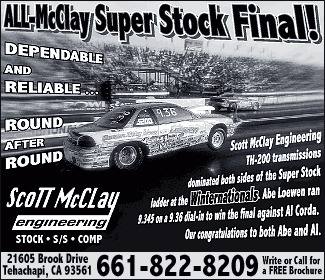
These master cylinders are manufactured with
an aluminum body along with a relatively large
capacity plastic reservoir with dual outlet
bores (which correctly face the driver side
fender when mounted in the car). If there is
a shortcoming to this master cylinder design,
it's the size of the outlet fittings. The front
fitting is a 9/16-20 Inverted Flare while the
rear is a 1/2-20 Inverted Flare. Unfortunately,
it's difficult to find appropriate adapter fittings
for these flare dimensions. Lamb Components
does offer a solution. They manufacture special
#3 A-N male adapters specifically for these
master cylinders (these Lamb fittings are relatively
inexpensive and a real frustration-saver). FYI,
the master cylinders sold by Mark Williams can
have these Lamb fittings installed as an option.
You'll also find that these
master cylinders
will require an adapter to fit the firewall
on
most vehicles. These adapters are
designed to convert something such
as a later model Firebird (which
originally came equipped with a
power booster) to the manual,
Mopar pattern. Lamb Components
offers several different adapters
for varied applications and so
does MPR (see the source box
for more information). |
You'll also find that these master cylinders
will require an adapter to fit the firewall
on most vehicles. These adapters are designed
to convert something such as a later model Firebird
(which originally came equipped with a power
booster) to the manual, Mopar pattern. Lamb
Components offers several different adapters
for varied applications and so does MPR (see
the source box for more information).
Pedal Pushers
The pedal ratio is critical. What's pedal ratio?
The brake pedal acts as a lever to increase
the force you (the driver) apply to the master
cylinder. In turn, the master cylinder forces
fluid to the disc brake caliper pistons or drum
brake wheel cylinders. If you examine a brake
pedal, you'll see the pivot point (where the
pedal swivels) and the mounting point for the
master cylinder pushrod are usually different.
By varying the length of the pedal, and/or the
distance between the pushrod mount and the pivot,
you can change how much force (from your leg)
is required to energize the master cylinder.
This is the "mechanical advantage" or pedal
ratio. This formula will help you figure it
out:
| |
Input
Force X Pedal Ratio = PSI
Brake
Piston Area
|
Translated, this is the amount of force exerted
by your leg times the pedal ratio divided by
the area of the brake piston(s). The typical
adult male can exert approximately 300 pounds
of force with one leg. If you've ever tried
leg presses at a gym at 300 pounds, you'll know
ADVERTISEMENT
 |
hat's
a bunch. Something in the order of 1/3 or 1/2
that figure is obviously more comfortable, even
in a racecar. Of course, you also use the brakes
to stage the car, and in some cases, racers
"pump" the pedal in an attempt to increase holding
power. But does this actually increase the brake
line pressure? According to Mark Williams, this
practice doesn't really change the pressure.
If you have to pump the pedal to increase the
holding power of the brakes, something has pushed
the pistons back in the caliper (run out in
the rotor, a cocked caliper, bad mounts are
all examples). Another common cause is air in
the system. Bottom line? If you have to pump
the brakes to hold a car on the starting line,
something is wrong. Pumping the pedal does not
build pressure, although it might eliminate
pedal travel.

|